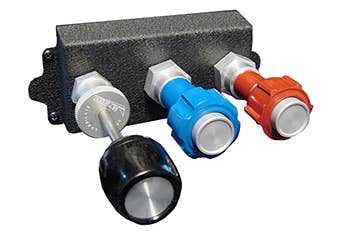
Chances are you've come across descriptions of how constant-speed propellers work, oh, about a thousand times since your piloting days began. Instead of rehashing how they operate, let's talk about tips you can use to get the most out of your constant-speed prop.
The first tip is offered with safety in mind: After you push the throttle full forward, gather momentum on the runway and lift off, don't touch the throttle (black knob), propeller (blue knob) or mixture (red knob) until you've reached a safe altitude. After all, if something is going to break, it might do so because you moved one of these levers. It's best to gain altitude before adjusting power settings.
You'll always want to refer to your POH for specific operating procedures, but we'll discuss general principles. First, you may have been taught to cycle the prop three times during the runup. This is a holdover from DC-3 and B-17 days. With most modern engines and propellers, cycling the prop once to ensure the system works is good enough, except on very cold days when you'll want to cycle that thick prop oil.
As you know, for takeoff in a typical light GA airplane — say a Cessna 182 — the throttle and propeller knobs should be in the full forward position. The mixture should be set for best power, which usually will be full forward as well when departing from airports below about 5,000 feet density altitude.
After initial climb when entering the cruise climb phase, now it's time to start moving levers. You'll start by moving the throttle lever back until the manifold pressure gauge reads the proper value; in the case of our 182 we're looking for 23 inches. Then you'll slowly rotate the blue knob until the rpm comes back to 2,400. This is the cruise climb setting for a Cessna 182Q.
Once you've reached cruise altitude, this is where the abundance of choices for throttle/mp setting makes having the POH nearby handy. You've probably been told at some point that flying "over square" can damage your engine; that is, allowing the manifold pressure reading to exceed the rpm reading can be harmful. This is also a holdover from days of yore and is generally untrue, although there are operating restrictions that limit certain mp/rpm combinations.
Looking at the POH for a 182Q, we can choose to cruise with the throttle set between 15 and 23 inches mp and the prop between 2,100 and 2,400 rpm. At 6,000 feet and standard temperature, as an example, pulling the throttle back to 20 inches mp and the prop back to 2,300 rpm will put us at 65 percent power burning 11.1 gallons an hour. In all, the 182Q's POH lists 17 different mp/rpm combinations to choose from at 6,000 feet.
The tip for reaching cruise altitude is to first let the airspeed increase after you level off and then reduce power by first pulling the throttle back and then the prop back.
If we now decide we want to climb to 8,000 feet, we start by rotating the blue prop knob, increasing the rpm to 2,400 and then moving the throttle forward to increase mp to 23 inches. Once we level off at 8,000 feet, we can pull the throttle back to 19 inches mp and then pull the prop back to 2,300 rpm to achieve 65 percent power, this time burning 10.6 gallons per hour. During prolonged climbs, you'll find that the throttle will need to be periodically advanced to maintain constant power.
The tip to remember is this: To reduce power we start with the knob closest to us, pulling the throttle back first and then moving to the prop knob. To increase power it's the opposite: start by moving the prop forward and then the throttle.
The descent is the easiest. We simply pull the throttle back to the desired setting and let the nose drop to descend until we choose to level off. Let's say we level off at pattern altitude. Now we'll want to increase power by moving the throttle forward (remember, the prop is already far enough forward), and then decrease power with the throttle as we start our final descent on base and final.
Here is the last important step in flying an airplane with a constant speed propeller. We need to slowly move the propeller lever to the full forward position before landing so that in case of a go-around we have maximum climb performance available. Here you'll follow the procedure outlined in your POH as you do your GUMPS check prior to landing.
The final tip is don't be too quick about bringing the prop to the full forward position during a normal approach because it will be annoyingly loud if the power is still up. If you need to go around, just be sure to push the throttle and the prop knobs fully forward.
Get exclusive online content like this delivered straight to your inbox by signing up for our free enewsletter.
We welcome your comments on flyingmag.com. In order to maintain a respectful environment, we ask that all comments be on-topic, respectful and spam-free. All comments made here are public and may be republished by Flying.

Sign-up for newsletters & special offers!
Get the latest FLYING stories & special offers delivered directly to your inbox






